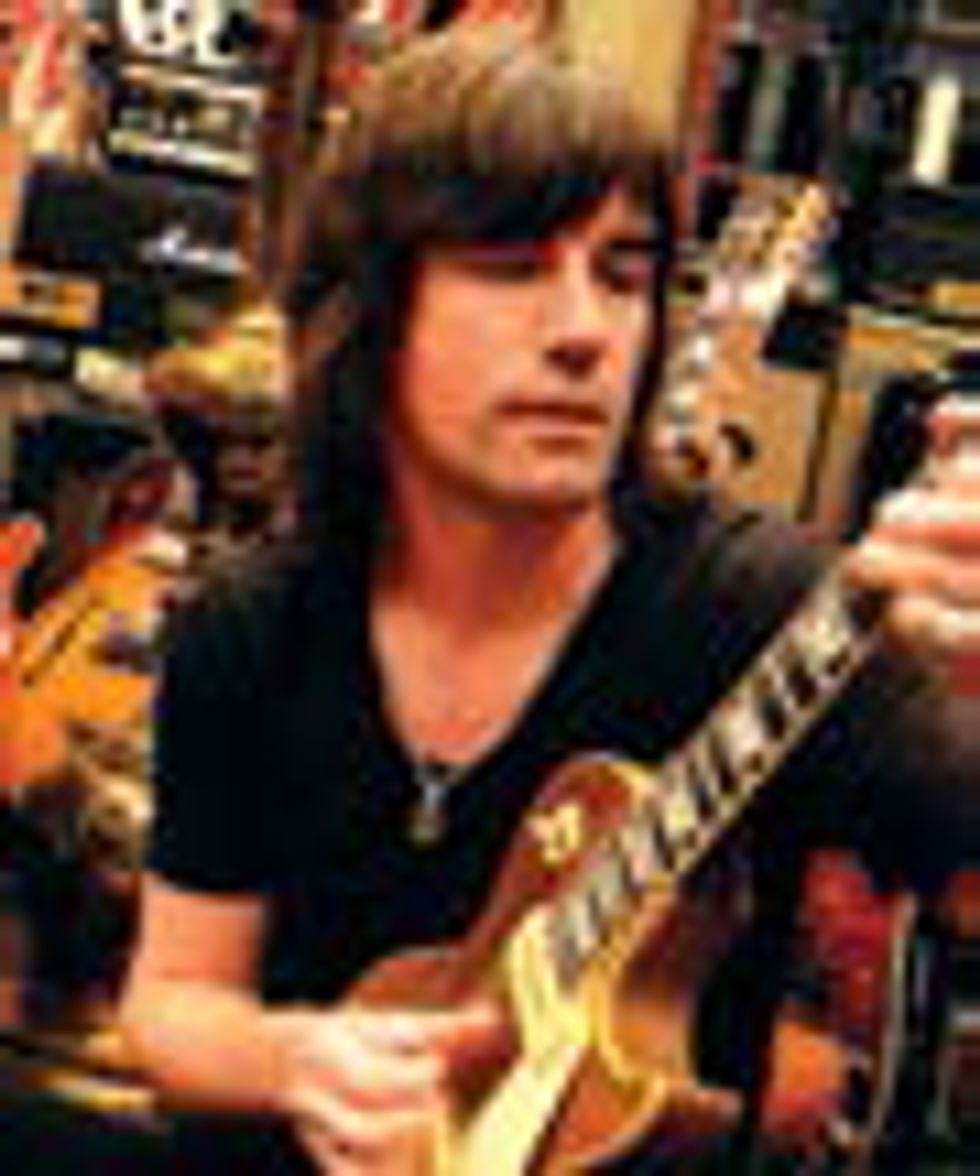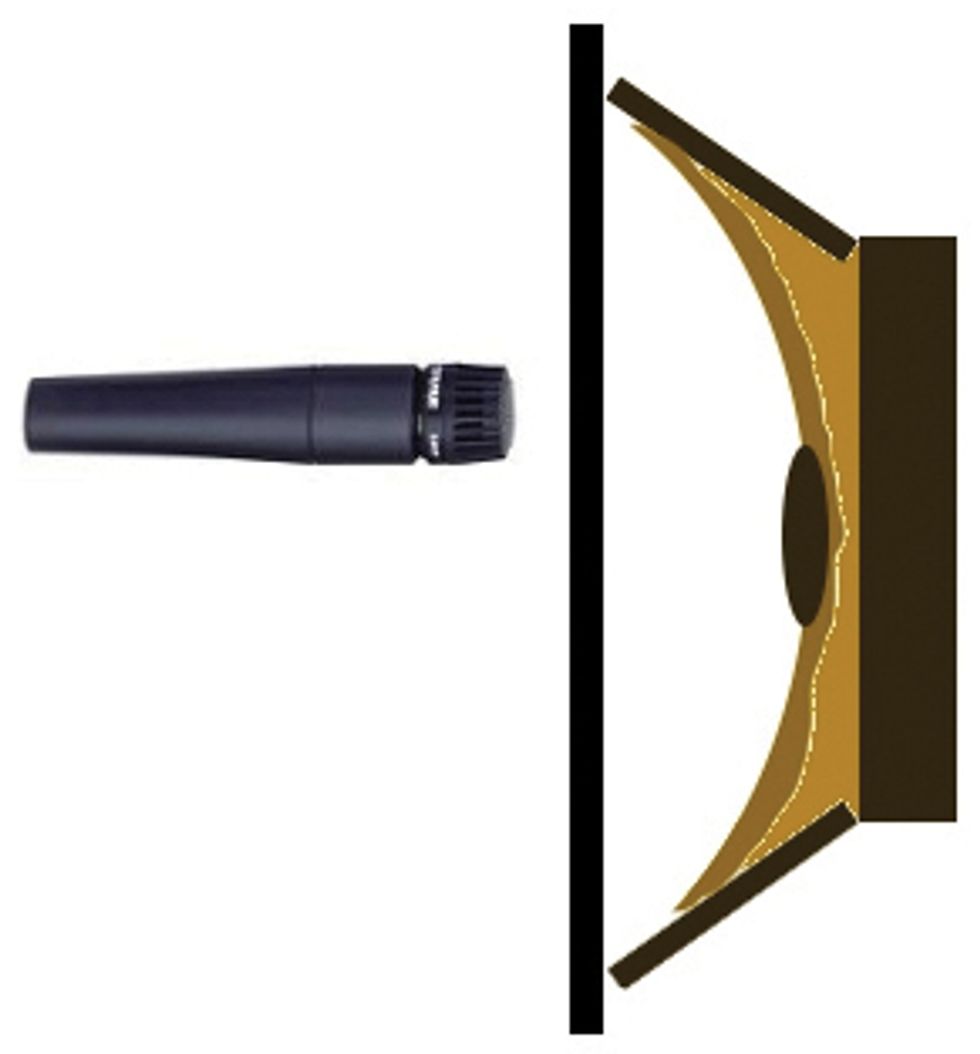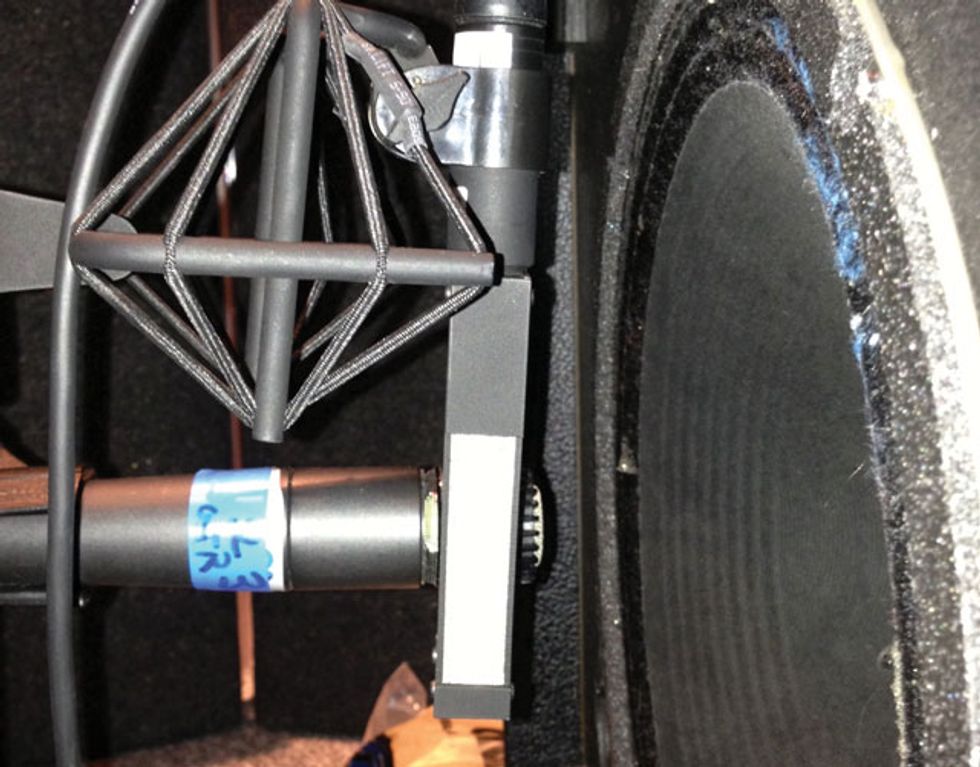As a professional guitarist, to feel like I’m covering all the bases I need a healthy balance of road and studio work. I really enjoy playing gigs and touring, but I also love creating new music in the studio. And the art of recording guitar well is a passion of mine. When I’m not on tour, I’m generally doing sessions and producing video gear demos for amp and pedal manufacturers. So having a studio of my own where I can record world-class guitar tones has become essential for me. I’ve had a good home studio for 10 years or so, but recently, I was presented with an opportunity to move my studio to an available room in a commercial facility. I learned many things in the process, so I’m going to give you some ideas in my next two columns for getting the most out of your own studios. This month, we’re going to focus on mic’ing guitar cabinets in the studio, but keep in mind that much of the info can be applied to the stage as well.
Mic that cab. The biggest change between my new space and my old home studio is that I now have an actual live tracking room. In my old studio, I used a coat closet to isolate and mic a 1x12 Bogner cabinet, but now I have enough space to record virtually any size cab. Yes, speaker simulators have come a long way (more on this in a minute), but there’s still just something about mics and speakers moving air.
In my old space, I surrounded the cab with 24" x 24" acoustic panels from ATS Acoustics to absorb volume and reflections. To isolate it from the floor, I also positioned the cab on sandbags I bought at the hardware store, and sometimes I’d cover it in packing blankets. Not only did all this work to eliminate reflections and absorb sound, cutting down the volume also helped ensure I wouldn’t disturb the neighbors.
Though the closet worked really well, it sure is nice to have a big room now. I can mic cabs in ways that I just couldn’t before. For example, I recently made a video demo of a Jim Kelley Reverb amplifier and I mic’d an open-back cab with an SM57 and an sE VR1 in front, along with an AKG C 214 in the back. Using a mic on the backside can add depth and air to the sound, but it was something I just didn’t have the room to do in my old space. If you do use a mic on the back of an open cab, just make sure you flip the phase of the rear mic because otherwise it’ll be out of phase with the front mic(s).
Fig. 1 This illustration shows the distance at which I normally place a SM57 from a speaker.
When using just one mic on a cab—which I still often do—I normally use the tried-and-true SM57 on a Celestion or Celestion-style speaker and place it at the distance shown in Fig. 1. This position always seems to work because I get a great balance of lows to highs. You can move the mic forward or back an inch or so, depending on how much proximity effect you need—the closer you get, the more the bass will be boosted.
If you do add a second mic, however, just be sure the diaphragms are aligned by making them equidistant from the speaker. Otherwise, you can get phase cancellation that can wreak havoc with your tone. (See the “Phase Coherency Test” sidebar for an easy trick to establish phase coherency between two mics.)
Phase Coherency Test
1.) Without a guitar plugged
in, turn up the gain of the amp
you are using until there is a fair
amount of hiss coming from the
speaker cab. Send this signal out
through a headphone send.
2.) Next, invert the phase of your
second mic on your mic pre or in
your DAW using a plug-in.
3.) Listen to the sound of the
amplifier hiss in your headphones.
When you move your second mic
towards or away from the speaker,
you will hear the hiss level change
as the mics go in and out of phase
with one another. The position
where you hear the least amount
of hiss is where the mic should
be placed. This is because when
the second mic’s phase-reversal
switch is flipped on, the sound
should cancel out as much as
possible. Unflip the phase on the
second mic, and voilà, you should
have a great tone when the two
mics are blended. My SM57 and
sE VR1 mics shown in Fig. 2 are
aligned for proper phase. You’ll
notice that the VR1 is placed
slightly back from the SM57.
Or don’t mic that cab. As I mentioned, speaker simulators have come a long way in recent times and they offer a viable alternative to mic’ing cabs. With the advent of impulse responses (IRs), it’s now possible to accurately capture the unique tonal signature of any speaker, mic, and preamp combination, and then turn it into an IR. I recently acquired a useful box that facilitates using IRs with tube amps. It’s called the Two Notes Torpedo Live, and this MIDI-compatible unit lets you safely connect and load any amplifier up to 100 watts. (Note: Tube amps must see a load, which is what your speaker cabinet serves as normally.) You can then use any of the included IRs—or make and use your own—and send a line-level signal out of the unit to your recording interface. What you end up with is an incredibly realistic mic’d amp tone.
Fig. 2 Had I not used the phase coherency test, I wouldn’t have known that this is precisely where the VR1 (second mic) should be placed in relation to the SM57.
From recording silently with headphones to being able to quickly audition different cabinet and mic combinations for your recordings, the advantages are obvious and many. The live application possibilities are also pretty incredible, since you’re able to switch between different virtual cabinets to get the tone you are going for, be it a closed-back 4x12 for dirty sounds or an open-back 2x12 for clean sounds. I’ve just started using this box, so I’m still in the honeymoon phase, but so far I’m definitely impressed with what it can do.
Next month, we’ll look at the control room. Meanwhile, happy tracking!
 Peter Thorn is an L.A.-based guitarist, currently touring
with Melissa Etheridge. His solo album,
Guitar Nerd, is available through iTunes and
cdbaby.com. Read more about his career at
peterthorn.com.
Peter Thorn is an L.A.-based guitarist, currently touring
with Melissa Etheridge. His solo album,
Guitar Nerd, is available through iTunes and
cdbaby.com. Read more about his career at
peterthorn.com.












![Rig Rundown: Russian Circles’ Mike Sullivan [2025]](https://www.premierguitar.com/media-library/youtube.jpg?id=62303631&width=1245&height=700&quality=70&coordinates=0%2C0%2C0%2C0)






